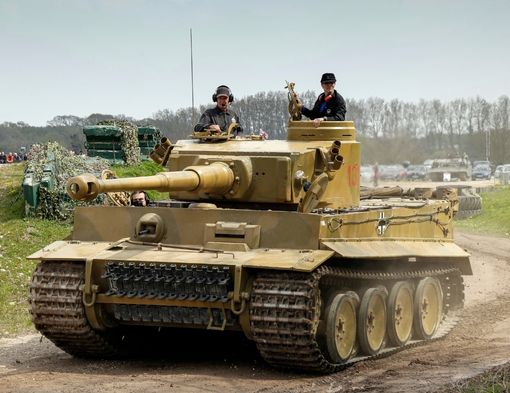In this article, written by Head of Marketing Nik Wyness, we’ll look at why Tiger 131 is so popular – and how The Tank Museum has benefited from it.
24th April 2023 marks the 80th anniversary of the capture of Tiger 131 in Tunisia, by British forces at Point 174. But why is Tiger 131 so popular?
Like the Mona Lisa is to the Louvre, so Tiger 131 is to The Tank Museum.
It’s not the most important tank in the collection, it’s not the best tank in the collection – and for many it’s not their favourite either. But it is the most famous.

THE MYTH OF THE TIGER TANK
We all know that the reputation of the Tiger Tank is based more on myth than fact. It symbolises Hitler’s combined obsession with size on the one hand, and propaganda value on the other.
What the German tank designers revealed on Hitler’s 50th birthday certainly looked the part. There is no doubt that the Allies were alarmed at the thought of its potential, which made them determined to get their hands on one. They would have to wait a full year before they could and when they did, it was Tiger 131.

In April 1943, Tiger 131 was fought to a standstill and abandoned in Tunisia; the first Tiger to be captured intact by the Western Allies, it was an important prize. King George VI and Churchill both came to see it in Tunisia, from where it was then shipped to London and displayed on Horse Guards parade. It was considered iconic even then.
The Tiger was a formidable opponent. It had a powerful 88m gun, thick armour and surprisingly good mobility.
As a result, the impact a Tiger tank could have on morale just from the threat it posed was significant. Allied tank crews lived in fear of an encounter with a Tiger even though this was, in practice, highly unlikely.
There were never enough Tigers in the field to have a genuine impact on the fortunes of the war, but the ripples created by their reputation arguably still resonate: fuelling the superiority myth of the Tiger and our fascination with it.

HISTORY OF TIGER 131
Just look at Tiger 131 and you’ll see what makes it so important to The Tank Museum as an artefact.
It bears the scars of the action in which it was captured and retains the field modifications made by the crew. We know what happened in its final fighting moments, giving this tank a unique place in history and very human story.
It is this history – this story – that gives Tiger 131 such a significant position in our collection.

POST WAR CELEBRITY
Almost 80 years on, Tiger 131 is no longer a feared weapon of war. Instead it has been a valued and much-studied museum piece since 1951.

Because of its unique history and its relatively complete condition, a plan to return it to running order was hatched in the early 1990s and completed in 2004. As the only running example in the world, Tiger 131 has become as part of The Tank Museum’s brand.
Searching for Tiger 131 on YouTube will bring up literally thousands of videos with millions of views. This makes Tiger 131 one of the most viewed individual museum artefacts in the world.
This level of fame, meant that when David Ayer wanted a real Tiger tank to feature in his movie Fury, a brief Google search was all it took to find Tiger 131. Tiger 131, like David Niven, Alec Guinness and Christopher Lee, can now be added to the distinguished list of Hollywood performers who were also World War Two veterans.
It’s appearance in Fury brought more fame, as Tiger 131 was immortalised in pixels when it became a playable vehicle in the online video game World of Tanks.
This kind of exposure meant that when, in 2017, the Museum united all members of the Tiger tank family in a new exhibition – The Tiger Tank Collection – visitors travelled from around the world to see the unique gathering.
No other tank in our collection can carry an event on its own like the Tiger – as it does at Tiger Day – and for now, it’s something that can’t be seen anywhere else.

FANS & FUNDRAISING
Tiger 131, a vehicle that has spent far more time as an operational vehicle with the Museum than it did with the German army, draws new admirers every day.
The sheer popularity of this tank and the way that we have been able to utilise its “fame” has been of vital importance to The Tank Museum in recent years.
It has helped us raise our profile around the world; increasing ticket sales, donations and retail sales with a range of books, models, artworks and fan merchandise.
As a registered charity, the ability to harness this star power in order to raise funds is incredibly important. Not only can the funds “earned” by Tiger 131 be reinvested into keeping it running, but we can invest even more into the care of the less famous and well-favoured vehicles in our collection.
We have seen the value of this particularly famous vehicle in reaching out to new audiences to help us snag their interest in the wider subject of armoured warfare and the reality of conflict.
As a result, we must conclude that Tiger 131 has been of enormous assistance in making us better at fulfilling our central mission as a museum and registered charity – “to tell the story of tanks and the people that served in them”.
See Tiger 131 in action in our upcoming Tiger Day, 16 September. Book tickets here.





